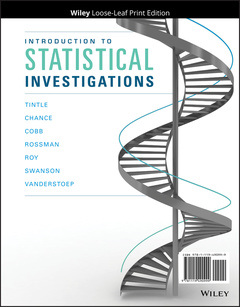Introduction to Statistical Investigations, Loose-Leaf Print Companion
Auteurs : Tintle Nathan, Chance Beth L., Cobb George W., Rossman Allan J., Roy Soma, Swanson Todd, VanderStoep Jill

It focuses on genuine research studies, active learning, and effective use of technology. Simulations and randomization tests introduce statistical inference, yielding a strong conceptual foundation that bridges students to theory-based inference approaches. Repetition allows students to see the logic and scope of inference. This implementation follows the GAISE recommendations endorsed by the American Statistical Association.
P.1 Introduction to the Six-Step Method
P.2 Exploring Data
P.3 Exploring Random Processes
Unit 1: Four Pillars of Inference: Strength, Size, Breadth, and Cause
1.0 Significance: How Strong Is the Evidence?
1.1 Introduction to Chance Models
1.2 Measuring the Strength of Evidence
1.3 Alternative Measure of Strength of Evidence
1.4 What Impacts Strength of Evidence?
1.5 Inference for a Single Proportion: Theory-Based Approach
2.0 Generalization: How Broadly Do the Results Apply?
2.1 Sampling from a Finite Population
2.2 Inference for a Single Quantitative Variable
2.3 Errors and Significance
3.0 Estimation: How Large is the Effect?
3.1 Statistical Inference: Confidence Intervals
3.2 2SD and Theory-Based Confidence Intervals for a Single Proportion
3.3 2SD and Theory-Based Confidence Intervals for a Single Mean
3.4 Factors that Affect the Width of a Confidence Interval
3.5 Cautions When Conducting Inference
4.0 Causation: Can We Say What Caused the Effect
4.1 Association and Confounding
4.2 Observational Studies versus Experiments
Unit 2: Comparing Groups
5.0 Comparing Two Groups
5.1 Comparing Two Groups: Categorical Response
5.2 Comparing Two Proportions: Simulation-Based Approach
5.3 Comparing Two Proportions: Theory-Based Approach
6.0 Comparing Two Means
6.1 Comparing Two Groups: Quantitative Response
6.2 Comparing two Means: Simulation-Based Approach
6.3 Comparing Two Means: Theory-Based Approach
7.0 Paired Data: One Quantitative Variable
7.1 Paired Designs
7.2 Analyzing Paired Data: Simulation-Based Approach
7.3 Analyzing Paired Data: Theory-Based Approach
Unit 3: Analyzing More General Situations
8.0 Comparing More Than Two Proportions
8.1 Comparing Multiple Proportions: Simulation-Based Approach
8.2 Comparing Multiple Proportions: Theory-Based Approach
9.0 Comparing More Than Two Means
9.1 Comparing Multiple Means: Simulation-Based Approach
9.2 Comparing Multiple Means: Theory-Based Approach
Two Quantitative Variables
10.1 Two Quantitative Variables: Scatterplots and Correlation
10.2 Inference for the Correlation Coefficient: Simulation-Based Approach
10.3 Least Squares Regression
10.4 Inference for the Regression Slope: Simulation-Based Approach
10.5 Inference for the Regression Slope: Theory-Based Approach
A: Calculation Details
B: Stratified and Cluster Samples
Solutions to Selected Exercises
Index
Nathan Tintle attained his Ph.D. in Statistics in 2005 from Stony Brook University and has been the primary mentor for over 95 undergraduate students in extended summer and/or academic year research projects in statistics, with the bulk of these students conducting research in statistical genetics and biostatistics.
Date de parution : 05-2018
Ouvrage de 704 p.
20.8x27.4 cm
Disponible chez l'éditeur (délai d'approvisionnement : 12 jours).
Prix indicatif 80,98 €
Ajouter au panier


